|
Do you have something
happening in your corner of Washington? - Please call a member
or e-mail your observations to have them included here
November:
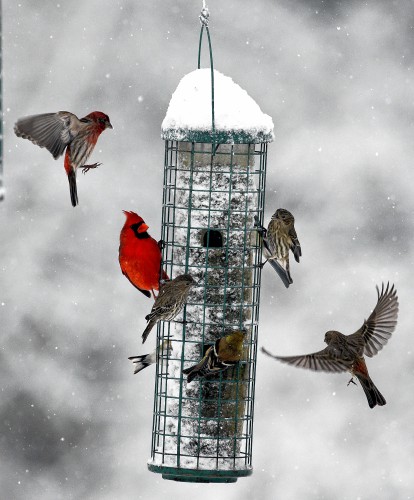
Photo by AP Photo/Mark Humphrey, Concord Monitor
Time to put out your bird feeder for the winter months! Bird feed is a tasty high-protein treat for the birds but can also very attractive to bears.
NH Fish and Game suggests that you wait at least until December 1 to put your bird feeder back up each year. But, if we have not had several days and nights of cold weather, bears may still be active and looking for food; then you should keep your feeder down until we have had several days of cold weather.
Although black bears are generally shy and usually avoid humans, they are opportunistic and will search for human food supplies when natural foods are not available. Bears are clever. This, coupled with their strength and agility, make it very difficult to establish bear-proof bird feeders. Clean up spilled seed below feeder stations. Bear damage to bird feeders is a common and growing spring complaint. Take down, clean and put away bird feeders by April 1. Store the bird feeder until late fall. Birds will do just fine with the natural foods available.
Information found at NH Fish and Game
October:
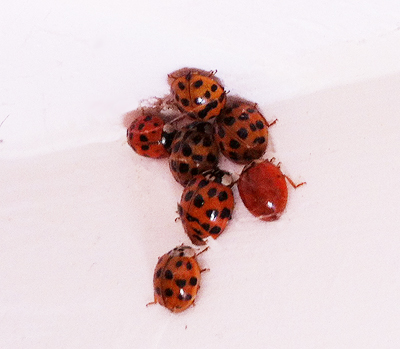
Photo by Nan Schwartz
As the days get shorter and nighttime temperatures drop, many people are starting to notice Asian ladybugs aggregating in or on their homes. While ladybugs are usually considered beneficial in the garden because they eat insect pests like aphids, they can be a nuisance in the fall when they invade buildings. Asian ladybugs are “overwintering” insects that hibernate as adults and spend the winter in protected places such as under tree bark or beneath the siding of buildings. Some insects accidentally make their way indoors and can be found crawling around windows, walls and ceilings. Fortunately, they are not dangerous to people, pets or the structure of the home and do not breed or lay eggs inside of buildings.
The best way to manage Asian ladybugs is to prevent them from getting inside the home in the first place. Remove air conditioners when they are no longer needed and take care to seal up cracks around windows and doors, particularly on the sunny southern and western sides of the house. Insects that get inside can be swept into a jar and released outdoors or sucked up with a vacuum cleaner. When ladybugs are disturbed, they often release an unpleasant odor and produce a yellowish staining fluid which can damage light colored rugs and upholstery. Staining is less likely to occur when vacuuming as opposed to sweeping them up. On rare occasions, Asian ladybugs may bite if picked up with bare hands. When threatened, they might use their chewing mouthparts to pinch the skin. These bites are not serious and can be avoided by wearing gloves.
Insecticides are not recommended for managing these pests as they work too slowly to control the problem and are toxic to people. Since lady bugs are beneficial predators, focus your energy on sealing up cracks where they might be getting into your home.
Some garden supply companies sell ladybug houses that are designed to provide hibernating habitat for ladybugs in the garden. While these houses might provide shelter for some ladybugs, they will not prevent ladybugs from coming into the home.
Information found at Emma Erler, UNH Cooperative Extension
September:
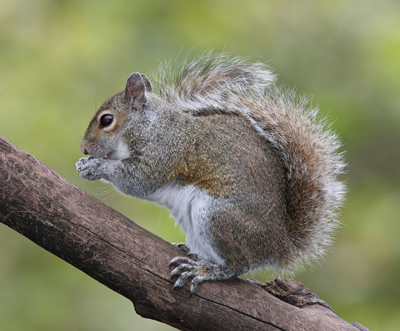
Photo by BirdPhotos.com
Where have all the squirrels and the chipmunks gone? Nan mentioned that she hasn't seen a single squirrel or chipmunk all summer long. Last year there were so many around causing all sorts of chaos, while desparately looking for food.
The squirrel apocalypse of 2018 was caused, first, by an abundant acorn crop in fall 2017, which meant many more squirrel babies. The next fall, there was a poor crop of beech nuts and of white and red acorns, especially red oak. Deer and turkeys quickly scarfed up what little of these materials were available.
So hungry squirrels left the woods and spent a lot of time running around looking for food, including a lot of time on busy roadways where they met their inevitable ends. A quick Google search shows this phenomenon has caused squirrels to do even weirder things, like swim across rivers in search of food. It turns out there are few chipmunks this year for the same reasons there was so much squirrel roadkill last fall.
“The same phenomenon that has knocked down the squirrel population decimated the chipmunk population”, said Kim Tuttle, New Hampshire Fish and Game Department wildlife biologist, “a massive acorn and nut crop failure last fall drove hundreds and hundreds of squirrels” to migrate away from their homes in search of food. And the chipmunks, too, “just ran out of food,” she said, and their search for food, which can also include birds, eggs and nestlings, made them more susceptible to predators.
Usually scurrying all over stone walls in the spring, those cute little striped rodents are difficult to find this year along with their larger cousins, the squirrel.
Is this all a sign of an ecological apocalypse? Apparently not. The abundance and shortage of nuts is “just cyclical”.
Information found at The Nashua Telegraph
August:
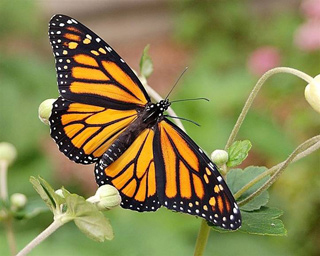
Photo by NH Fish & Game
In the last two decades Monarch Butterfly populations have declined by 84% in the US. These iconic butterflies migrate thousands of miles each year between Mexico and Southern Canada.
This summer in Washington we were happy to witness a small boom in the population. Many of us have seen the butterflies drinking nectar, caterpillars feeding on Milkweed and watch pupae developing and hatching out as new butterflies. It is fascinating to see!
There are four distinct life stages: egg, larva (caterpillar), pupa (chrysalis), and adult. During the summer breeding season, adults live for 2-5 weeks – up to four generations each summer – each one traveling a little further north than the last.
Monarch adults are nearly 4 inches wide with wings are orange with black veins and black margins dotted with white. The caterpillar is banded with yellow, black and white stripes. The chrysalis is blue-green with a band of black and gold. Lucky for them, Monarchs are toxic to most wildlife.
They can live anywhere that there is nectar, drinking nectar from a variety of flowering plants, making them important pollinators! But they will only breed when the larva’s food source, milkweed, is nearby. The caterpillars can only survive on a milkweed diet.
The last generation of monarch butterflies born in northern states in August do not breed, but instead begin flying south to Mexico for the winter. Throughout their journey they are vulnerable to fall hurricanes, early frosts and cold snaps. The flowers that they need to fuel their journey are also going dormant for the winter!
Information found at NH Fish & Game
July:
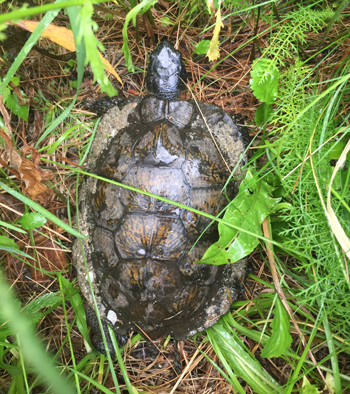
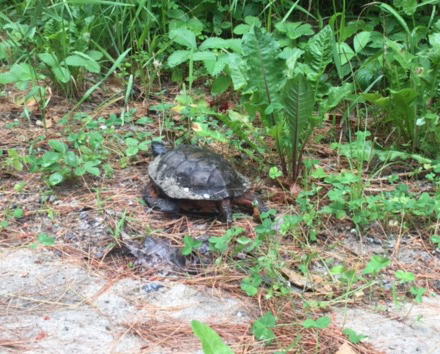
Photos by Arin Mills
Arin reported that Phil saw a Wood Turtle in LAE. He was surprised to find it walking near the road and ran home to get Arin so she could see it.
Larger than the painted turtle, smaller than the snapping turtle, New Hampshire’s wood turtle has been a protected species since 2008. Now, efforts are underway to ensure the shelled amphibian doesn’t get upgraded from “species of concern” to “threatened species.” While wood turtles have some healthy populations in parts of the state, their numbers have dropped significantly over the years due largely to human interference either through road and agricultural development or through poaching. There are old historic records of wood turtles being among the most abundant turtles in New Hampshire and New England but that’s just not the case anymore.
The 9-inch-long wood turtles are moderately sized by New Hampshire standards with a bright orange neck and legs. Poachers have been known to collect wood turtles to sell them out of state to people who want them as pets. Owning or collecting wood turtles is illegal in New Hampshire and many other Northeast states.
They are different from most other turtle species in the area in that they prefer to live in and around rivers and streams. Other species can be less picky about which types of watersheds they take up residence in. So when a river or stream is obstructed by development or shrubs are mowed to make way for farmland, their habitat shrinks.
The constraints on their habitat are half of the problem. Turtles are evolved to live long adult lives and reproduce frequently, while a small fraction of turtle babies survive into adulthood. They live long lives, to as old as 60 to 90 years, and they’re reproducing that whole time. They can lay eggs up until the point they die, so an 80-year-old female turtle can lay as many or more eggs than a 20-year-old turtle. The reason they’re in such trouble is they depend on extremely high survival rates for the adults. So if even one adult turtle is struck by an automobile or stolen by a poacher, that can have far-reaching and long-lasting impacts on the larger turtle population.
We are lucky to have this rare turtle living in this area, please watch out when driving and help keep their habitat safe for them. If you happen to see one let NH Fish & Game know about it!
Article found at Hippo Press.com
June:
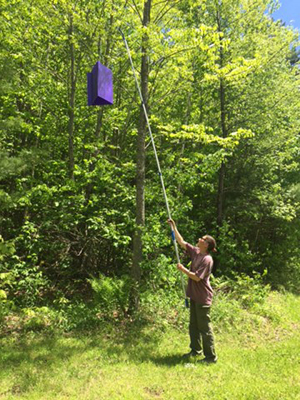
Photo by Dode Gladders
The Emerald Ash Borer (EAB) is responsible for the death and decline of tens of millions of ash trees and has been detected in 15 states. EAB was found in Concord in March 2013, and the infestation continues to grow. It was found in Deering in 2017 and moved into Hillsboro in 2018. As a non-native insect, EAB lacks predators to keep it in check. The EAB attacks ash trees and infested trees die within 3 to 5 years.
Recently our county forester, Dode Gladders, worked with Arin to hang some Emerald Ash Borer Survey traps in the Camp Morgan Town Forest. These funny looking purple, sticky traps will aid in detecting the presence of the EAB in Washington.
The traps are hung in ash trees, in the lower to middle canopy, on the sunny side of the tree and most typically the south or southwest side.
The mechanics of the trap are simple and straight forward. In their adult stage, EAB beetles fly around ash trees, nibbling on leaves and looking for a mate. If an EAB lands on a purple trap it gets stuck in the glue. In mid-summer, survey crews return to the trapping sites to refresh the lure (which attracts the pest) and collect any insects stuck on the traps. In the fall, they will return to the trap sites a second time to collect samples and remove the trap.
You can help protect New Hampshire's forests by reporting suspect trees or insects. You can consider insecticide treatment of some trees to keep ash in the understory. You can be aware of the risks of spreading EAB and use best management practices to avoid transporting this pest to your favorite outdoor spot. If you go camping, leave your firewood home and buy your firewood where you will burn it.
May:
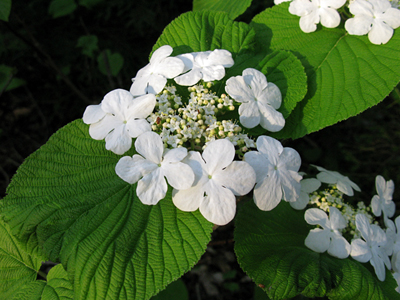
Photo by Thomas L. Muller
Arin said that she noticed that the Hobblebush or witch-hobble is blooming.
The
Viburnum lantanoides (commonly known as hobble-bush, witch-hobble, alder-leaved viburnum, American wayfaring tree and moosewood) is a perennial shrub, growing 6–12 ft high with pendulous branches that take root where they touch the ground. These rooted branches form obstacles which easily trip (or hobble) walkers – hence the common name.
The shrub forms large flat-topped clusters of white to pink flowers in May–June. The flowers have a lacy effect similar to some hydrangeas and contrast well with the medium green foliage. The flowers on the outer edge of the clusters are much larger, an inch to two inches across and the whole cluster is typically 4 inches across. The large showy flowers along the edge of the cluster are sterile, while the small inner flowers have both male and female parts. The bush has large, heart shaped leaves which are serrated with a sharp tip, about 4 to 5 inches long. The bark is gray-brown and warty and the fruit is a red fleshy fruit with a thin skin, which turns to black when ripe. The fall foliage is usually bright red.
The flowers provide nectar for the Celastrina ladon (Spring Azure) butterfly. Mammals and birds feed on its fruit, twigs, and leaves.
The Hobblebush is found in the eastern U.S. and Canada from Georgia to the Canadian Maritimes. It grows in rich, moist, acidic woods, stream banks, and swamps.
Article found at Wikipedia
April:
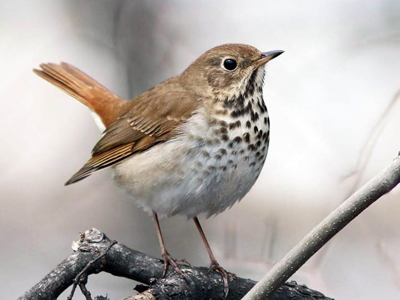
Photo by Yves Gauthier/Cornell Lab of Ornithology
A neighbor of Arin’s recently heard the pretty song of the Hermit Thrush, back from it’s winter home.
An unassuming bird with a lovely, melancholy flute-like song, the Hermit Thrush lurks in the understories of far northern forests in summer and is a frequent winter companion across much of the country.
The Hermit Thrush has a rich brown upper body and smudged spots on the breast, with a reddish tail that sets it apart from similar species in its genus. Hermit Thrushes have a chunky shape similar to an American Robin, but smaller. They stand upright, often with the slender, straight bill slightly raised. Like other thrushes, the head is round and the tail fairly long.
Look for the Hermit Thrush in forest openings or along trails. In spring and summer, you'll likely hear their mournful, flute-like song, “oh, holy holy, ah, purity purity eeh, sweetly sweetly” long before you see them. In winter they are frequently near berry-bearing plants. Hermit Thrushes make several distinct calls around their nests. They will sometimes make a rising byob sound similar to a canary call or mewing kitten. Females frequently rearrange their eggs while making "quit quit" noises. In the morning, two adults meeting near the nest will greet each other with a "pweet pweet" call.
Hermit Thrushes usually make their nests in and around trees and shrubs, but they can also get more creative. Nests have been found on a cemetery grave, on a golf course, and in a mine shaft. The female builds the nest from grass, leaves, pine needles, and bits of wood, with mud and lichen around the outside. She lines the nest with finer plant materials and willow catkins.
Males usually gather food for the nest, while females feed the nestlings. The young birds start by eating bits of larvae, then grasshoppers, moths, and spiders. Hermit Thrushes forage on the forest floor and will often hop and then stay still, peering at the ground. They sometimes pick up leaf litter with their bills or shake grass with their feet to find insects. When they’re about to fly, they flick their wings or tails.
Listen for their beautiful song!
Information found at: Cornell Ornithology Labs - All About Birds
March:
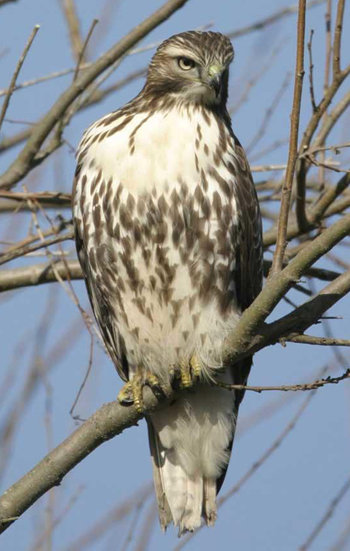
Photo by Richard Crossley/VIREO
Jed and Nan saw a juvenile Red-tailed Hawk in their yard keeping an eye out for prey under their bird feeder from a tree across the street. Wow, it was a big bird!
The Red-tailed Hawk is a bird of open country, of deserts, fields, roadsides, pastures, parks and open woodlands – places where it can hunt for rodents and build a large stick nest in a tree. It has adapted well to human environments, including the habitats along our highways, where you can often see hawks sitting in a tree, on a telephone pole, or in the roadside grass.
Red-tails mostly hunt from perches, watching for movement at the woodland edge or in grassy meadows below. Prey includes voles, mice, rats, rabbits, chipmunks, and squirrels and sometimes snakes, frogs, insects, pigeons and other birds – most anything smaller than a woodchuck. They also feed on carrion. A red-tailed hawk can hover like a kite in strong wind and swoop down to catch an unsuspecting meadow vole. A mated pair will sometimes hunt together, working in tandem to catch a squirrel or other prey.
Red-tails excel at soaring. They master the wind, flying in slow, wide circles, their four-foot wingspan slightly upturned. When they do flap their wings, their muscular wing beat is slow, strong and deliberate.
The call of an adult red-tailed hawk is a harsh descending scream, "kee-eeeee-arr", that lasts two to three seconds and is often heard when the bird is soaring.
Named for its beautiful brick-red tail and recognized by its large, stocky shape, the red-tailed hawk is the classic Buteo: the group of hawks noted for their broad, roundish wings and a relatively short, wide tail – and for their mastery of soaring. The “red-tail” is the largest of the Buteos that we see in New Hampshire; others include the broad-winged, red-shouldered and rough-legged hawks. It can be 19-25” long with a 45-52” wingspan and the female is 20 - 25% heavier than the male.
Red-tailed hawks mate for life; the pair take turns incubating the eggs and feeding the young. They aggressively defend their territory; the female stays closer to the nest, while the male patrols the territorial boundaries. On clear days, they soar over their territory with a keen eye toward potential intruders, such as other hawks and eagles. The size of the territory ranges from 80 to 200 acres, depending on the availability of food, perches and nest sites.
The NH House has just voted to pass a bill to designate the Red-tailed Hawk as the Official State Raptor, approving a bill brought forward twice by students from Hampton Falls to honor the bird, the bill now goes to the Senate.
Article found at NH Fish and Game
February:
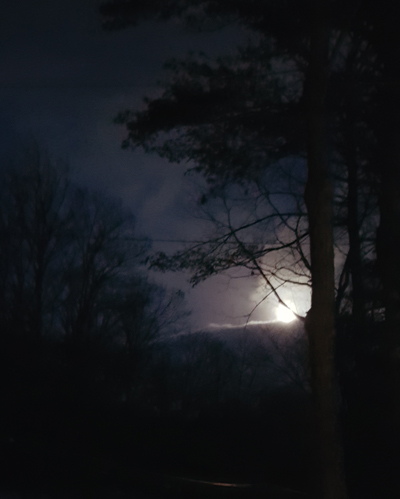
Super moon picture by Johanna Young
The Super Snow moon
February's full moon will brighten the skies on Tuesday, February 19th as the biggest and brightest super moon of the year.
The super snow moon is the second of three super moon events in the first three months of the year -- a packed lunar calendar for 2019. It will make the moon appear unusually large when it rises and sets, and -- like most lunar events -- is sure to draw amateur star gazers around the world outside.
The super moon will occur during this full moon because it will be closest in its orbit to Earth. Moonrise is the best time for those interested in capturing dramatic super moon photos because the moon will be closest to the horizon. The moon looking deceptively large is known as a "Moon illusion," which occurs when the moon is close to the horizon and objects such as buildings or trees are in front of it for scale, which tricks our brains into thinking the moon is closer to the objects than it really is.
Why is it called the snow moon?
Each month, the full moon carries a different name signifying what is most associated with that time. This is because centuries ago, lunar months were associated with the changing seasons rather than the solar year.
Native Americans and Europeans gave February the "snow moon" title because it was the month associated with heavy snowfall, according to The Old Farmer's Almanac. February's moon has also been called the bone or hunger moon due to the lack of food available in the winter.
The super moon marks a big difference from 2018, when there was no full moon in February -- called a Black Moon. This occurs once every 19 years, and it's because January and March each had two full moons.
In January, we were treated to the super blood wolf moon, which had a remarkable red tinge.
And if you missed this one, there will be another super moon on March 19 -- the last of three super moons visible at the start of this year.
Article found at CNN
January:
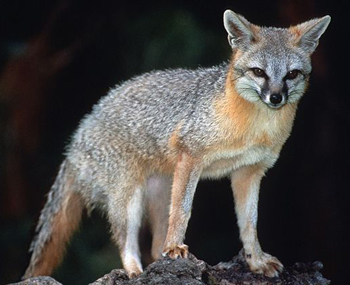
Gray Fox picture from Wikipedia
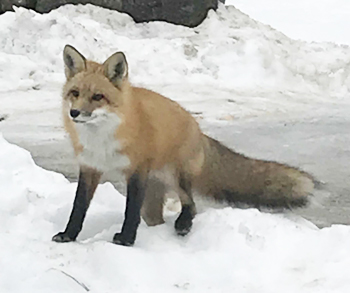
Red Fox picture by Jed Schwartz
Arin and Shayne recently spotted a Gray Fox near Ashuelot Drive. We wondered how they differ from Red Foxes, which have been spotted more often in Washington.
A glimpse of a cherry-red fox against the backdrop of snow-covered fields is a sight to behold. Both red and gray foxes live in the Granite State, but the red fox is far more abundant and has a widespread range. Gray foxes are more common in southern New Hampshire, and are rarely recorded up north in Coos County. Unlike red foxes, gray foxes (which can climb trees) are able to co-exist with coyotes.
The larger of the two foxes, the red fox has a sleek, lean appearance, compared to the more stout and robust gray fox. The red fox is generally reddish, though shades may vary, and has a distinct white tip on its tail. The gray fox has a line of black-tipped fur down its back. The upper part of its gray coat is grizzled with guard hairs banded with gray, black and white; the under parts range from light-colored, buff and white to reddish. The gray fox's tail is tipped with black.
The gray fox prefers more wooded and brushy habitat, while its cousin, the red fox, inhabits fields and farm country. Gray foxes have always been here, but have never been as numerous as red foxes. The gray fox's diet changes with the season, ranging from grasshoppers, grapes and apples in the summer months, to small mammals like mice, voles and squirrels at other times of year. In the last decade, New Hampshire trappers have taken about 100 gray fox each year.
Eric P. Orff, Certified wildlife Biologist
Article found at NH Fish and Wildlife
To view yearly archives of our "New In
Nature" series click on year you wish to see.
2002
2003
2004
2005
2006
2007
2008
2009
2010
2011
2012
2013
2014
2015
2016
2017
2018
|


